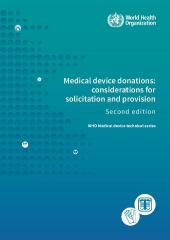WHO Medical Device Donation

Supporting the World Health Organization (WHO) in providing guidelines for medical device donations
Partners
World Health Organization (WHO)
Objectives
Medical devices play a vital role in preventing, diagnosing, and treating illnesses, as well as aiding in patient rehabilitation. Low-income countries rely on donations to enhance access to medical products and technologies, particularly during emergencies. In 2011, the World Health Organization (WHO) issued the first guidelines for medical device donations. These guidelines have been updated through this project, which incorporates previous advice with new findings and references. It addresses considerations for requesting and providing medical devices, the risks of unsuitable donations, and the duties of both donors and recipients. The guidelines also outline the necessary steps to take before, during, and after a donation.
The guideline is divided into three sections. The first section identifies common issues encountered during the donation process. The second section outlines best practices for both donors and recipients. The third section highlights scenarios that demand special attention due to their complexity or specific requirements.
Additionally, the document contains three annexes. The first lists criteria for donation acceptability. The second provides a literature review on medical device donations from 2010 to 2023. The third annex is a flyer designed to independently remind donors and recipients of their responsibilities.
This document is intended to improve the quality of medical devices donations, including medical equipment, single-use medical devices and in-vitro diagnostics, to provide maximum benefit to all stakeholders. The considerations can be used to develop institutional or national policies and regulations for medical devices donations. This document is intended for use by any organization, expert or practitioner involved in the donation, procurement, management of medical devices, including health workers, biomedical engineers, health managers, policymakers, donors, nongovernmental organizations and academic institutions.
Funding
This project was funded by the World Health Organization.
Supporting the World Health Organization (WHO) in providing guidelines for medical device donations
Partners
World Health Organization (WHO)
Objectives
Medical devices play a vital role in preventing, diagnosing, and treating illnesses, as well as aiding in patient rehabilitation. Low-income countries rely on donations to enhance access to medical products and technologies, particularly during emergencies. In 2011, the World Health Organization (WHO) issued the first guidelines for medical device donations. These guidelines have been updated through this project, which incorporates previous advice with new findings and references. It addresses considerations for requesting and providing medical devices, the risks of unsuitable donations, and the duties of both donors and recipients. The guidelines also outline the necessary steps to take before, during, and after a donation.
The guideline is divided into three sections. The first section identifies common issues encountered during the donation process. The second section outlines best practices for both donors and recipients. The third section highlights scenarios that demand special attention due to their complexity or specific requirements.
Additionally, the document contains three annexes. The first lists criteria for donation acceptability. The second provides a literature review on medical device donations from 2010 to 2023. The third annex is a flyer designed to independently remind donors and recipients of their responsibilities.
This document is intended to improve the quality of medical devices donations, including medical equipment, single-use medical devices and in-vitro diagnostics, to provide maximum benefit to all stakeholders. The considerations can be used to develop institutional or national policies and regulations for medical devices donations. This document is intended for use by any organization, expert or practitioner involved in the donation, procurement, management of medical devices, including health workers, biomedical engineers, health managers, policymakers, donors, nongovernmental organizations and academic institutions.
Funding
This project was funded by the World Health Organization.

